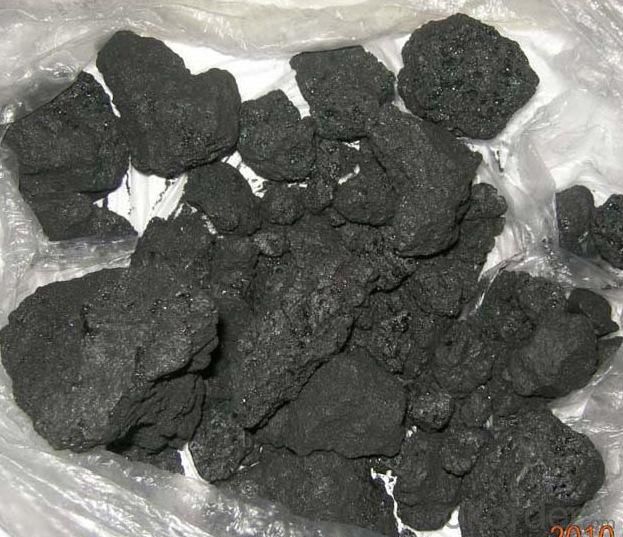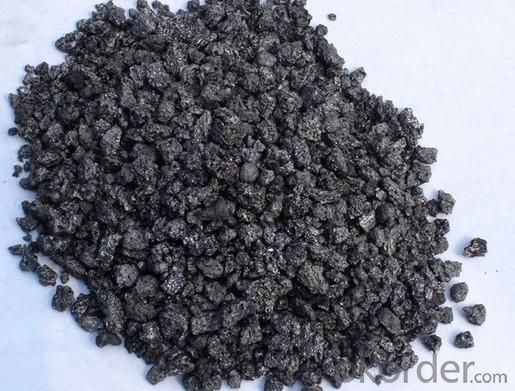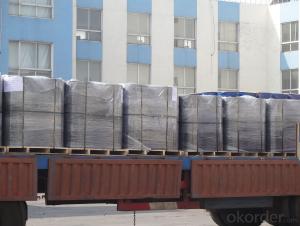Calcined Petroleum Coke 98.5%-Coke Fuel of CNBM in China
- Loading Port:
- Tianjin
- Payment Terms:
- TT OR LC
- Min Order Qty:
- 1 m.t.
- Supply Capability:
- 10000000 m.t./month
OKorder Service Pledge
OKorder Financial Service
You Might Also Like
1.Structure of Calcined Petroleum Coke Description
Calcined Petroleum Coke is made from raw petroleum coke,which is calcined in furnace at a high temperature(1200-1300℃).CPC/Calcined Petroleum Coke is widely used in steelmaking,castings manufacture and other metallurgical industry as a kind of recarburizer because of its high fixed carbon content,low sulfur content and high absorb rate.Besides,it is also a best kind of raw materials for producing artifical graphite(GPC/Graphitized Petroleum Coke) under the graphitizing temperature(2800℃).
2.Main Features of the Calcined Petroleum Coke
High-purity graphitized petroleum coke is made from high quality petroleum coke under a temperature of 2,500-3,500°C. As a high-purity carbon material, it has characteristics of high fixed carbon content, low sulfur, low ash, low porosity etc.It can be used as carbon raiser (Recarburizer) to produce high quality steel,cast iron and alloy.It can also be used in plastic and rubber as an additive.
3. Calcined Petroleum Coke Images


4. Calcined Petroleum Coke Specification
| Place of Origin: | China (Mainland) | Type: | Petroleum Coke | Sulphur Content (%): | 0.5 |
| Ash Content (%): | 0.4 | Fixed Carbon (%): | 98.5 | Moisture (%): | 2 |
| Volatile Matter (%): | 0.3 | Brand Name: | cnbm |
5.FAQ of Calcined Petroleum Coke
1). Q: Are you a factory or trading company?
A: We are a factory.
2). Q: Where is your factory located? How can I visit there?
A: Our factory is located in ShanXi, HeNan, China. You are warmly welcomed to visit us!
3). Q: How can I get some samples?
A: Please connect me for samples
4). Q: Can the price be cheaper?
A: Of course, you will be offered a good discount for big amount.
- Q:What are the impacts of carbon emissions on the stability of islands?
- The impacts of carbon emissions on the stability of islands are significant and wide-ranging. Carbon emissions contribute to climate change, which in turn leads to sea level rise, increased storm intensity, and ocean acidification – all of which pose great threats to the stability of islands. Sea level rise is one of the most immediate and visible impacts of carbon emissions on islands. As global temperatures rise, glaciers and ice caps melt, and ocean waters expand, causing sea levels to gradually increase. This rise in sea level puts low-lying islands at risk of inundation, erosion, and even disappearing completely. Many small islands, particularly in the Pacific and Indian Oceans, are already experiencing the effects of rising sea levels, leading to loss of land, displacement of populations, and destruction of infrastructure. Another impact of carbon emissions on islands is the increased intensity and frequency of storms. Warmer ocean temperatures fuel the formation of tropical storms and hurricanes, which can cause devastating damage to island communities. These storms can result in widespread destruction of homes, infrastructure, and ecosystems, leading to long-term economic and social disruptions. Islands are particularly vulnerable to storm surges, which occur when high winds push seawater onto land, causing extensive flooding and erosion. Ocean acidification, caused by the absorption of excess carbon dioxide by the ocean, is another significant impact of carbon emissions on islands. Increased levels of carbon dioxide in the atmosphere lead to increased absorption by the ocean, resulting in a decrease in pH levels and making the ocean more acidic. This acidification poses a threat to coral reefs, which are vital for island ecosystems and serve as natural barriers against wave action and storm surge. Coral reefs provide habitats for a wide array of marine life and are important for tourism and local economies. The loss or degradation of coral reefs due to ocean acidification affects not only the biodiversity but also the resilience of islands to climate-related impacts. Overall, the impacts of carbon emissions on the stability of islands are profound and severe. Rising sea levels, increased storm intensity, and ocean acidification all pose significant threats to the physical and social stability of island communities. Urgent action is needed to mitigate carbon emissions, invest in adaptation measures, and support island nations in building resilience to these impacts.
- Q:What's the difference between coal and carbon?
- Coal has a certain luster, which contains a certain mineral oil, etc., is a relatively tight crystal structure. After baking coal coke, coal tar removal became less organized a lot of voids in carbon, most of which are carbon elements. Carbon produced by coal; also called coke. In addition, wood charcoal is also called charcoal.Coal and carbon can all be used as fuel. Most coal burns with smoke and may smell. Carbon burning generally does not have too much smoke, but also less odor.Carbon gap structure makes carbon have good adsorption, so carbon is often used as adsorbent material, used for adsorption of water, odor and so on.
- Q:What is the burning point of carbon?
- There are many forms of carbon, such as charcoal, coal, and even diamonds!And different forms have different ignition points!
- Q:How is carbon used in the production of fertilizers?
- Fertilizer production relies on carbon as a vital ingredient. Various forms of carbon, such as organic matter, carbon dioxide, and carbonates, are used for this purpose. These carbon sources have multiple benefits, including enhancing soil fertility, promoting plant growth, and increasing crop yield. Organic matter, such as compost, manure, and crop residues, contains decomposed plant and animal materials, providing carbon to the soil. When incorporated into the soil, these organic sources supply plants with essential nutrients like nitrogen, phosphorus, and potassium. They also improve soil structure, water retention, and microbial activity, all of which are crucial for optimal plant growth. Carbon dioxide (CO2) is another valuable source of carbon utilized in fertilizer production. This greenhouse gas is captured from industrial emissions and utilized in the production process. CO2 is transformed into different chemical compounds like urea and ammonium bicarbonate, which serve as nitrogen fertilizers. These fertilizers gradually release nitrogen, ensuring a continuous supply of nutrients to plants over an extended period. Furthermore, carbonates, particularly calcium carbonate, are employed as neutralizing agents in fertilizers. They aid in balancing the pH levels of acidic soils, making them more suitable for plant growth. Additionally, carbonates provide a source of calcium, an essential nutrient that further enhances plant growth and development. To summarize, carbon plays a critical role in fertilizer production by providing essential nutrients, improving soil fertility, and enhancing plant growth. Whether in the form of organic matter, carbon dioxide, or carbonates, carbon is an indispensable component that contributes to the success of modern agriculture.
- Q:How does carbon monoxide affect human health?
- Human health can be severely impacted by carbon monoxide, a highly toxic gas. When we breathe it in, carbon monoxide enters our bloodstream and binds with hemoglobin, the molecule responsible for delivering oxygen to our cells. This binding is incredibly strong and hampers the effective delivery of oxygen, resulting in a condition known as carboxyhemoglobinemia. The symptoms of carbon monoxide poisoning can vary depending on the concentration and duration of exposure. Initially, individuals may experience mild symptoms like headaches, fatigue, dizziness, and nausea. However, if exposure continues or occurs at higher concentrations, these symptoms can escalate to confusion, impaired judgment, loss of consciousness, and even death. One of the most dangerous aspects of carbon monoxide is its ability to go unnoticed, as it lacks color, odor, and taste. This makes it difficult to detect its presence without proper monitoring equipment. Carbon monoxide poisoning can arise from various sources, including faulty heating systems, poorly ventilated appliances, and running engines in enclosed spaces. Prolonged or repeated exposure to carbon monoxide can result in long-term health consequences. It can lead to neurological damage, memory loss, cognitive impairment, and even permanent brain damage. Additionally, it can worsen existing cardiovascular conditions, increasing the chances of heart attacks and strokes. To safeguard ourselves from carbon monoxide poisoning, it is crucial to ensure proper ventilation and functional carbon monoxide detectors in our homes and workplaces. Regular maintenance of appliances and heating systems is also essential to minimize the risk of leaks. Recognizing the symptoms of carbon monoxide poisoning and seeking immediate medical attention are vital in preventing severe health outcomes.
- Q:How does carbon impact the productivity of marine ecosystems?
- Carbon impacts the productivity of marine ecosystems in several ways. One of the main ways is through ocean acidification. When carbon dioxide from human activities is released into the atmosphere, a significant portion of it gets absorbed by the oceans. This excess carbon dioxide reacts with seawater to form carbonic acid, leading to a decrease in the pH of the ocean. This increase in acidity has detrimental effects on many marine organisms, especially those that rely on calcium carbonate to build their shells or skeletons, such as corals, shellfish, and some plankton species. Ocean acidification inhibits the process of calcification, making it difficult for these organisms to develop and maintain their protective structures. This not only affects their survival but also impacts the entire food chain. Many species rely on these calcium carbonate structures as a food source or for shelter, so a decline in their productivity can have cascading effects on the ecosystem. Additionally, increased carbon dioxide levels in the ocean can also affect the metabolism and physiology of marine organisms. Some studies have found that elevated CO2 concentrations can impair the growth, development, and reproductive success of certain species. This can lead to a decrease in overall productivity within the ecosystem. Furthermore, climate change, driven by the accumulation of carbon dioxide in the atmosphere, also impacts marine ecosystems. Rising temperatures can disrupt the delicate balance of marine ecosystems, affecting the distribution and abundance of species, altering predator-prey relationships, and leading to changes in the timing of vital ecological events such as spawning or migration. These changes can have profound impacts on the productivity of marine ecosystems, as different species may struggle to adapt or compete under new conditions. In conclusion, carbon dioxide emissions have far-reaching consequences for marine ecosystems. Ocean acidification and climate change, driven by excessive carbon dioxide, have detrimental effects on the productivity of marine ecosystems, affecting the growth, survival, and reproductive success of marine organisms. The impacts of carbon on marine ecosystems highlight the urgent need to reduce greenhouse gas emissions and mitigate the effects of climate change to protect these fragile and vital ecosystems.
- Q:How is carbon used in the production of ink?
- Various forms of carbon, such as carbon black or activated carbon, are employed in the production of ink. Carbon black, a fine black powder derived from incomplete petroleum combustion, is commonly used as a pigment to achieve deep black color in inks. Its small size and high surface area enable even dispersion in the ink, ensuring consistent color. On the other hand, activated carbon is a porous carbon form produced by heating materials like wood or coconut shells at high temperatures. In ink production, it functions as a filter or purification agent. With its extensive surface area and microscopic pores, activated carbon effectively adsorbs contaminants and impurities from the ink, enhancing its quality and stability for a smooth flow. In addition to its purification role, carbon also serves as a conductive material in ink production. Carbon-based inks, widely utilized in applications requiring electrical conductivity such as printed circuit boards, sensors, or electronic devices, consist of dispersed carbon particles in a liquid medium. This allows them to be printed or deposited onto a substrate, creating conductive pathways. Overall, carbon's vital role in ink production encompasses providing color, acting as a purification agent, and enabling electrical conductivity. Its adaptable properties and vast range of applications establish it as an indispensable component in the ink manufacturing process.
- Q:How does carbon dioxide affect the acidity of rainwater?
- The presence of carbon dioxide in rainwater has an impact on its acidity due to its contribution to the creation of carbonic acid. When carbon dioxide dissolves in rainwater, it engages in a reaction with water molecules, resulting in the formation of carbonic acid. This reaction causes an elevation in the concentration of hydrogen ions (H+) within the water, ultimately leading to a decrease in pH and the production of acidic rainwater. Although the carbonic acid generated from carbon dioxide is classified as a weak acid, it still possesses the ability to reduce the pH level of rainwater, rendering it more acidic than usual. This heightened acidity can result in harmful consequences for the environment, such as the destruction of plant and animal life, the corrosion of buildings and infrastructure, and the disruption of aquatic ecosystems.
- Q:What is the structure of graphite, another form of carbon?
- Graphite is a unique form of carbon that exhibits a distinct structure, different from other forms such as diamond or amorphous carbon. Its structure consists of layers of carbon atoms arranged in a hexagonal lattice. Each carbon atom forms covalent bonds with three neighboring carbon atoms, resulting in a two-dimensional sheet-like structure. Within each layer, the carbon atoms are bonded together through strong covalent bonds, forming a planar network. The carbon-carbon bonds in graphite are significantly stronger than typical single bonds, making the structure highly stable. The hexagonal lattice arrangement of carbon atoms creates a honeycomb-like pattern, giving graphite its characteristic appearance. The layers in graphite are held together by weak van der Waals forces, allowing them to slide past each other with ease. This property gives graphite its lubricating nature, as well as its ability to leave a mark on paper when used as a pencil lead. The arrangement of carbon atoms in graphite also leads to its excellent electrical conductivity. The delocalized electrons in the structure can move freely along the layers, allowing for the flow of electric current. This property makes graphite useful in various applications, including electrical components, electrodes, and as a lubricant in high-temperature environments. In summary, the structure of graphite consists of layers of carbon atoms arranged in a hexagonal lattice, bonded together by strong covalent bonds within each layer and held together by weak van der Waals forces between the layers. This unique structure gives graphite its distinct properties, such as its lubricating nature, electrical conductivity, and versatility in various industrial applications.
- Q:What is the atomic number of carbon?
- The atomic number of carbon is 6.
1. Manufacturer Overview |
|
|---|---|
| Location | |
| Year Established | |
| Annual Output Value | |
| Main Markets | |
| Company Certifications | |
2. Manufacturer Certificates |
|
|---|---|
| a) Certification Name | |
| Range | |
| Reference | |
| Validity Period | |
3. Manufacturer Capability |
|
|---|---|
| a)Trade Capacity | |
| Nearest Port | |
| Export Percentage | |
| No.of Employees in Trade Department | |
| Language Spoken: | |
| b)Factory Information | |
| Factory Size: | |
| No. of Production Lines | |
| Contract Manufacturing | |
| Product Price Range | |
Send your message to us
Calcined Petroleum Coke 98.5%-Coke Fuel of CNBM in China
- Loading Port:
- Tianjin
- Payment Terms:
- TT OR LC
- Min Order Qty:
- 1 m.t.
- Supply Capability:
- 10000000 m.t./month
OKorder Service Pledge
OKorder Financial Service
Similar products
New products
Hot products
Hot Searches
Related keywords



























